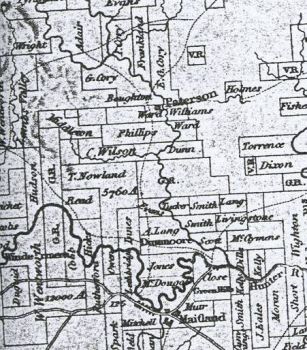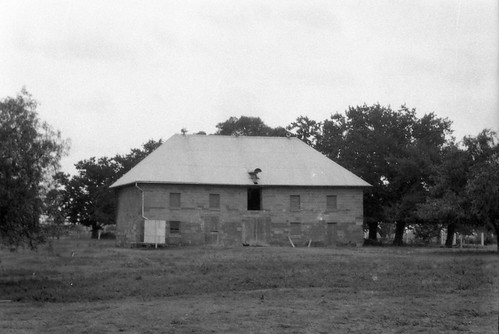John Brown and Richard Jones - Settlers
Map 2
John Brown
John Brown arrived on the Minerva in 1821 the same vessel that brought John Bingle to the colonies.John Brown brought with him recommendations from Earl Bathurst dated 4 August 1819 [3]. In an order dated 8th March 1822, two thousand acres were granted and he was permitted six convicts who would be victualled from the Stores at Newcastle for six months. [4]
Convicts assigned to John Brown in 1822 / 1823 included:
Stephen Green arrived on the Minerva. Assigned to John Brown 9th March 1822
John Brown arrived on the Ocean and assigned to John Brown 19 September 1823
John Morton arrived on the Ocean and assigned to John Brown 19 September 1823
This land was sometimes referred to as 'Brown's brush', notably when Jacob's Mob bushrangers were chased into the area by Alexander McLeod in 1825.
A notice in the Sydney Gazette in 1825 reveals that John Brown was in financial difficulty -
In the Supreme Court, Owen v. Brown - To be sold by auction by direction of the sheriff, the defendants farm and premises situated on the banks of Hunter's River and known by the name of Upper and Lower Bulwarra; containing by estimation 2200 acres of land, 60 of which are cleared and in cultivation, partly fenced and about 12 acres of maize growing thereon. [6]
Perhaps he remained on the estate as the Australian reported in February 1827 -
Mr. John Brown, of Bulwarra, Wallis' Plains, sustained a great loss by the thunder storm of last week. A barn, containing 1200 bushels of wheat was struck with the electric fluid and the whole was consumed. A large gum tree, which was within fifty yards of the barn was shivered to pieces. [7]
Thomas Potter Macqueen
John Brown sold Bolwarra to Thomas Potter MacQueen via agent Peter McIntyre.[1]In 1830, it was reported that Peter McIntyre on his estate at Bolwarra, had grown some excellent hops, samples of which were available at A.B. Sparks' George Street, Sydney Store. The colonial tobacco was considered - 'twisted and flavoured equal to Havannah par excellence'. William Vivers managed Bolwarra for McIntyre in this year.
In the Sydney Gazette in October 1832 an account of the fate of John Brown who had come to the colony with enthusiasm and promise was reported-
Coroner's inquest -
The Coroner for Sydney and a jury of the usual number assembled on Sunday last, at the Loggerheads public house in Market Street, on view of the body of Mr. John Brown, who died suddenly on the preceding night in a house in Clarence street. From the evidence adduced, it appeared that the deceased who was formerly proprietor of the Bolwarra Estate and has expended a large fortune in the colony had experienced some serious disappointments in his pecuniary affairs, which induced him to fly to the rum bottle and steep his senses in forgetfulness. To excess in this baneful antidote his death was evidently attributable and the jury returned a verdict of Died by the visitation of God. [6]
Bolwarra was offered for sale in 1833.....
Bolwarra containing 2,000 acres, a Grant from the Crown, situated on the Banks of the River Hunter, at the head of the navigation, and about a mile from the Town of Maitland ; bounded on the west by the River. Hunter, which on this side affords a constant and abundant supply of fresh water in the driest seasons, and will float barge of 30 tons. Bounded on the north by Goulburn Grove; the property of Standish Lawrence Harris; on the south by Mr. McDougall's land; and on the east by the River Hunter. On this side the water frontage extends several miles, and the River is navigable for any vessel the St. Michael Store ship at Green Hills, where the Steamers at present ply to, and which is only a few miles distant.
The splendour of the scenery, and the fertility of the soil, together with the local advantages, are so well known as to require no comment. There are about 300 acres cleared and under cultivation, and about 60 acres more have been felled up wards of twelve months, now ready to burn off. There are two hop gardens on the Estate, in extent about twelve acres. 'There are several beautiful and extensive lagoons or lakes on the Estate, and several extensive swamps, affording sufficient pasturage in the driest season. A new dwelling-house has lately been erected the view from which is magnificent. A considerable extent of fencing has been put up. [2]

Richard Jones
The land was acquired by Richard Jones a wealthy merchant, whale fishery owner and importer of Saxon sheep. Jones had returned to Australia on the Hugh Crawford with his wife in 1825, having previously spent several years in the colony.Richard Jones was a founder of the Bank of Australia in 1826 and President of the bank of NSW in 1828. He was appointed to the Legislative Council in 1829. In 1837 he offered one thousand acres of the east side of the Bolwarra Estate for sale.
The advertisement stated that the new road from East Maitland to the North would pass through the estate and the water frontage extended for some miles all of which was deep water. If no offers were made it was his intention to divide the estate into suitable allotments. [8]
Richard Jones lost much in the depression of the 1840's and became insolvent in 1843. He later held large properties in southern Queensland.
In 1849 Richard Jones ('formerly of Bolwarra') resided at Moreton Bay where he had been 'growing tropical crops for four years.' He died at his home at New Farm, Brisbane in 1852.
Notes and Links
The original house was built for Richard Jones in 1836 on a grant of 2030 acres known as Bulwarra Estate granted to John Brown, June 30,1823 (area now known as Bolwarra). Photograph 1933-
Find more buildings in the vicinity of Bolwarra
References
[1] Wood, W. Allan., Dawn in the valley : the story of settlement in the Hunter River Valley to 1833 Sydney : Wentworth Books, 1972., p. 94[2] Sydney Monitor 6 March 1833
[3] Ancestry.com. New South Wales, Australia, Colonial Secretary's Papers, 1788-1825 (NRS 898) Special bundles, 1794-1825 Item: 4/1094 Page: 105
[4] Ancestry.com. New South Wales, Australia, Colonial Secretary's Papers, 1788-1825 (NRS 937) Copies of letters sent within the Colony, 1814-1825 Item: 4/3504A Page: 540
[5] Sydney Gazette 16 October 1832
[6] Sydney Gazette 31 March 1825
[7] The Australian 16 February 1827
[8] The Sydney Herald 25 May 1837
↑
